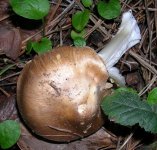dippers said:
Hi Richard, no expert but the mixed woodland one looks like Tricholomopsis platyphylla in my Phillips book.
cheers, Martin
Hi Richard,
The right-hand fungus is a
Mycena, a large genus, and without information on microscopic characters it is usually unsafe to suggest identifications. However, this looks exactly like
Mycena galopus, a variable but common species in a variety of situations. The diagnostic field character would be a white 'latex' oozing from any break in the stem and, if we look at the stem base in the photograph, we can see this latex.
Mycena galopus it is.
The left-hand fungus is more troublesome, but I think Martin is right. It does look like
Megacollybia (
Tricholomopsis)
platyphylla.
The gills should not be turning brown, but if this is some kind of ageing or drying effect and the spores are white, then this is a reasonable identification. The gills are relatively distant and look to have the right texture for this species.
The alternative would be an
Inocybe, another large and very difficult genus, characterised by "snuff brown" spores, and. like
Megacollybia, possessed of a cap surface with radiating fibrils. However, the cap is smoother than most species in the genus and the stem lacks characters I would expect. I did first think of an
Inocybe, but the more I examine the photographs, the more convinced I am that this is indeed
M. platyphylla.
Alan






